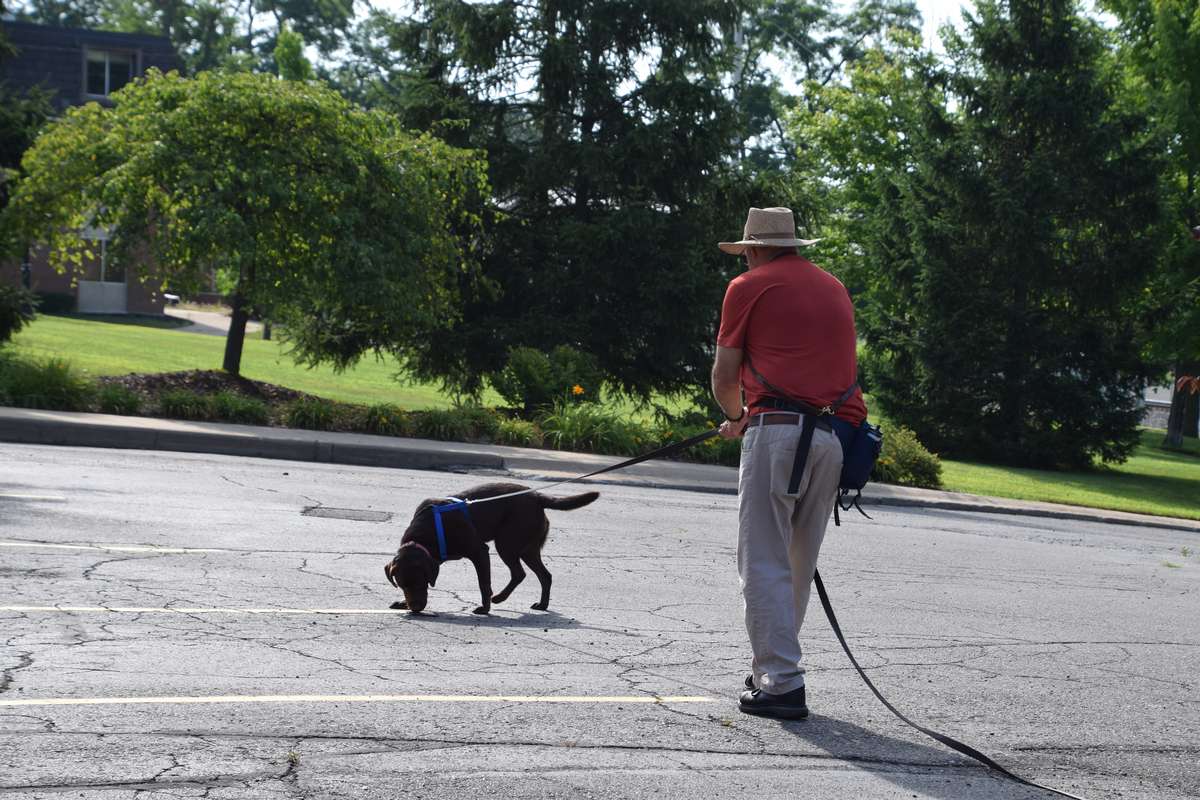
Buyer Beware

Affordably Priced Detection, Tracking & Service Dogs
We’ve all heard the old saying, “Beauty is in the eye of the beholder.” When it comes to detection, tracking and service dogs, the same could be said of their value. Value is in the eye of the beholder. However, there are factors to consider when valuing a dog and their intended purpose. These factors include supply vs demand, salability, and behavioral characteristics.
The value of detection, tracking, and service dogs is determined by the reliable outcomes the dog provides for a client. Like any commodity, price is based on supply and demand. If a certain breed, sex, and or age is selling quicker than others, then the price for that product will increase until supply is reached or exceeds demand. Ultimately, demand is a large factor in pricing.
The salability of Detection, Tracking, & Service Dogs
A dog’s marketability is influenced by many aspects, one being the genetic makeup. large vs. small frame, shedding vs. non-shedding. Many people prefer non-shedding dogs thus making them more valuable. The type and amount of training a dog needs to do reliable work, factors into the price. A well-behaved pet does not require as much training as a highly trained narcotics detection dog or service dog that must pass a public access test.
Influencers of Behavioral Characteristic
A dog's behavioral characteristic influences their value based on their sociability, nerves, drives, hardness, focus, and activity level scores. An older dog can be priced more than a younger dog because they score higher in each of these categories. A young dog with great potential may be priced higher than its littermate because we see amazing possibilities. Likewise, a dog could be priced lower due to non-favorable nerves and lack of drive for detection work but would make an awesome pet. Behavioral characteristics correlate with a dog’s value given the purpose of their jobs.
Owning a Detection, Tracking, or Service Dog
Consumers need to understand that we know the value of our dogs in the marketplace. If a dog is priced at $5,000 and another dog is priced at $30,000 there is a reason for the decision. A lower-priced dog may or may not be a perfect fit for your wants and needs. A person who desires a dog with sought-after marketable skills that are of no value to them would be paying for a dog that is overpriced for their needs. Our decisions regarding prices are based on the dogs’ behavioral characteristics, level of training, and market demand.
When considering a dog, ask and we will tell you about the reasoning behind the purchase price. Be honest with us about your needs and desires. Our goal is to provide you with the best match for your circumstances within your budget.
If you tell us that you want a fully off-leash trained high drive detection/tracking dog that is good with kids, cats, and crowds, but only has a few thousand to spend, we will tell you that such an animal cannot be purchased for that price. Anyone who tells you they have such a dog for that price is either not very knowledgeable or they are not forthcoming about the dogs’ ability and you will be an unhappy dog owner after the sale. To help you identify the type of dog you want, and need check out our Intentional Growth Plan for Dog and Handler.
Be Intentional and become part of the Equip K9 family.
Equip K9 offers only the best when it comes to Intentionally Growing your skills as a dog handler. Our main goal is to provide your family with not only a solid obedient dog but also a dog that demonstrates Loyalty, Trust, and Reliability with a willingness to please and have fun with.

Four-step Plan to Get the Dog of Your Dreams!
Looking For That Dream Dog?
Consider this four-step plan for getting the dog of your dreams.
Acquiring a new companion is a remarkable and memorable moment for your family and you. However, many people do not consider the long-term effects when picking a puppy. Rather, they let their emotions direct snap decisions and fail to consider whether the dog will be living with them for the next 10 – 12 years, for better or worse. To have the best possible outcome for the next decade, consider thinking about what you envision the dog to be like as an adult. Here at Equip K9 we begin with the end in mind when choosing a breeding or acquiring a dog.
1. Begin With the End in Mind
Write down on a piece of paper what you want the dog to do at the age of two. What will your dog’s purpose be? Consider your lifestyle, are you an active jogger, bicyclist, or are you more the movie-watching type? Maybe you like going out to eat at outdoor restaurants, visiting farmers' markets or RV camping, hiking, hunting, competitive sports… the list is endless in what you can do with your dog. However, this is the first step in choosing the right dog for you and your family. Equip K9, first considers the genetic qualities for health and soundness, then pedigree for potential capability, and finally the temperament characteristics of the dog.
2. Breed Genetics, Pedigree & Bloodline
Genetics tells the story of health and soundness. Tests are done by veterinarians where results are documented by third-party organizations like the Orthopedic Foundation for Animals - OFA. This allows people to make sound decisions in their purchase of a dog or breeding programs. Genetic testing results tells the breeder and prospective purchasers the likelihood of genetic problems that may or may not be present in a prospective puppy. The pedigree tells the story of the puppy’s lineage and if there were accomplishments by dogs in the puppy’s lineage. A pedigree can be filled with all kinds of champions, field trials, hunt tests, obedience, agility, tracking, detection … the list goes on and on. How does Equip K9 utilize this information to choose a puppy or adult dog? By keeping the end game in mind. If we are looking for a field trial or detection dog, then we want a dog that has a high hunt drive. Whereas if we are looking for a service dog, then we are looking for a dog that is calm, relaxed yet alert in their environment and of course friendly. A high-powered field trial dogs’ pedigree may not complement a calm service dogs’ pedigree. However, the genetics within both types of dogs could be held to the same desirable standards. Meaning, excellent hips, and elbows, no eye problems, no allergies … the list goes on and on per breed. Here at Equip K9, we consider both the genetic health and soundness of a puppy, as well as the accomplishments within the puppy’s pedigree lineage.
3. Temperament
In short, temperament is the dog’s personality/nature. A dogs’ temperament is biologically based and consists of several characteristics which can be observed. Temperament characteristics to consider are sociability, nerve, drive, hardness, and energy level.
Sociability: When observing sociability in a dog, a dog will display one of the following three behaviors. Social, the dog will confidently approach a stranger, Neutral, the dog will ignore the presence of a stranger, or the Unsocial dog that will not allow any stranger to approach by displays of fight-or-flight tendencies.
Nerve: This is the ability of the dog to adapt to changes within their changing environments or social stimuli. Adaptability falls on a continuum with anxiety on one end of the spectrum and fluidity on the other end.
Drive: Are a display of a dog’s biological instinct, which can be used to motivate the dog. It is important to understand that a dogs drives coincides with a dog’s nerves. The following list of canine drives is not all-inclusive. However, these are the more common ones to consider when choosing a puppy. Food, Prey, Hunt, Pack, and Defense.
Hardness: Is the ability of the dog to deal with correction. Again, this is a biological characteristic that cannot be moved much. It is unlikely that a soft dog will become a hard dog or vice versa. Hardiness falls on a spectrum with a soft dog being on one end and a hard dog being on the other end. Ideally, a dog in the middle of this spectrum is easier to train.
Energy Level: When assessing the energy level of a dog you are observing how active the dog is in the presence of stimuli. A hyperactive dog will be very excited and energetic in the presence of stimuli, while a languorous dog would be more aloof and unenergetic. If I were looking for a movie-watching buddy, I would gravitate towards the latter energy level dog.
4. Focus/Engagement
Engagement relates to how the dog interacts with the handler. Is the dog interested in me? The three words dependent, independent, and interdependent can tell the handler how they are going to interact with the dog. Dependent, means I depend on you. You, (the handler) provide me (the dog) with my needs, wants, and desires. Independent, means I don’t need you. I (the dog) provide for my wants needs and desires. Interdependent means We. We (dog and handler) are interdependent on each other for our wants needs and desires. Though the dog is dependent on you for many things, an interdependent relationship will produce the best-behaved dog. This brings me to focus. A dog’s focus will either be outwardly focused or inwardly focused. An outwardly focused dog pays attention to all the distractions in the environment. An inwardly focused dog pays attention to the handler and dismisses the distractions in the environment. Ultimately, we want engagement with our dog and the handler's responsibility is to provide that!
Be Intentional and become part of the Equip K9 family.
Equip K9 offers only the best when it comes to Intentionally Growing your skills as a dog handler. Our main goal is to provide your family with not only a solid obedient dog but also a dog that demonstrates Loyalty, Trust, and Reliability with a willingness to please and have fun with.
